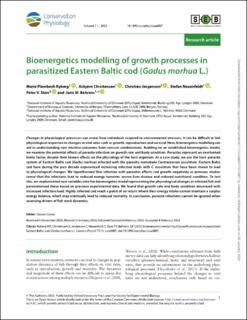| dc.contributor.author | Ryberg, Marie Plambech | |
| dc.contributor.author | Christensen, Asbjørn | |
| dc.contributor.author | Jørgensen, Christian | |
| dc.contributor.author | Neuenfeldt, Stefan | |
| dc.contributor.author | Skov, Peter V. | |
| dc.contributor.author | Behrens, Jane W. | |
| dc.date.accessioned | 2024-03-19T10:38:59Z | |
| dc.date.available | 2024-03-19T10:38:59Z | |
| dc.date.created | 2023-04-17T18:47:55Z | |
| dc.date.issued | 2023 | |
| dc.identifier.issn | 2051-1434 | |
| dc.identifier.uri | https://hdl.handle.net/11250/3123077 | |
| dc.description.abstract | Changes in physiological processes can reveal how individuals respond to environmental stressors. It can be difficult to link physiological responses to changes in vital rates such as growth, reproduction and survival. Here, bioenergetics modelling can aid in understanding non-intuitive outcomes from stressor combinations. Building on an established bioenergetics model, we examine the potential effects of parasite infection on growth rate and body condition. Parasites represent an overlooked biotic factor, despite their known effects on the physiology of the host organism. As a case study, we use the host–parasite system of Eastern Baltic cod (Gadus morhua) infected with the parasitic nematode Contraceacum osculatum. Eastern Baltic cod have during the past decade experienced increasing infection loads with C. osculatum that have been shown to lead to physiological changes. We hypothesized that infection with parasites affects cod growth negatively as previous studies reveal that the infections lead to reduced energy turnover, severe liver disease and reduced nutritional condition. To test this, we implemented new variables into the bioenergetics model representing the physiological changes in infected fish and parameterized these based on previous experimental data. We found that growth rate and body condition decreased with increased infection load. Highly infected cod reach a point of no return where their energy intake cannot maintain a surplus energy balance, which may eventually lead to induced mortality. In conclusion, parasite infections cannot be ignored when assessing drivers of fish stock dynamics. | en_US |
| dc.language.iso | eng | en_US |
| dc.publisher | Oxford University Press | en_US |
| dc.rights | Navngivelse 4.0 Internasjonal | * |
| dc.rights.uri | http://creativecommons.org/licenses/by/4.0/deed.no | * |
| dc.title | Bioenergetics modelling of growth processes in parasitized Eastern Baltic cod (Gadus morhua L.) | en_US |
| dc.type | Journal article | en_US |
| dc.type | Peer reviewed | en_US |
| dc.description.version | publishedVersion | en_US |
| dc.rights.holder | Copyright 2023 The Author(s) | en_US |
| dc.source.articlenumber | coad007 | en_US |
| cristin.ispublished | true | |
| cristin.fulltext | original | |
| cristin.qualitycode | 1 | |
| dc.identifier.doi | 10.1093/conphys/coad007 | |
| dc.identifier.cristin | 2141415 | |
| dc.source.journal | Conservation Physiology | en_US |
| dc.identifier.citation | Conservation Physiology. 2023, 11 (1), coad007. | en_US |
| dc.source.volume | 11 | en_US |
| dc.source.issue | 1 | en_US |

